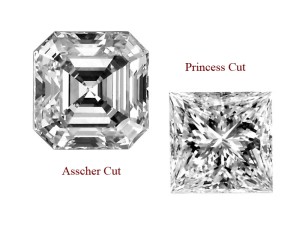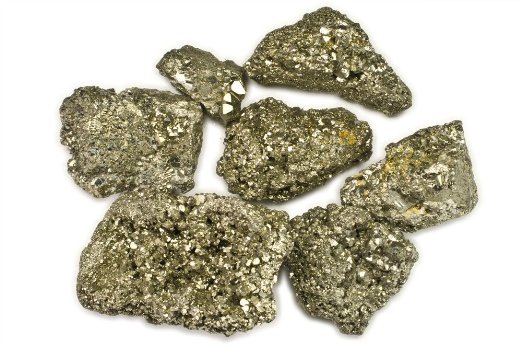What Is a Princess Cut?
Princess-cut diamonds have a square/rectangular outline, and this cut is one of the most popular ones, although not as much in demand as the round cut.

The princess cut was created in the 1960s and is a good choice if you want the brilliance of a round diamond but prefer a more rectangular shape.
See here loose princess-cut diamonds and their current prices.
What Is an Asscher Cut?
The Asscher cut is the square variation of the traditional emerald diamond cut.
Similar to the princess cut, the Asscher cut has a rectangular-looking shape with truncated corners.
Here you can see a selection of Asscher-cut diamonds.
Both the emerald cut and the common Asscher cut have 58 facets, but there is a variation called “Royal Asscher Cut” that has 74 facets.
How Princess and Asscher Cuts Differ
Despite their similar profiles, the princess and the Asscher cut differ in the way they are formed, which also affects how brilliant and colorless they look.
Let’s examine these differences in more depth:
Cut
While both cuts appear similar, they are actually fundamentally different in terms of how their facets are shaped and arranged.
The Asscher cut is a step cut, meaning that its facets run parallel to the girdle and/or each other.
The princess cut, on the other hand, is often referred to as a “modified brilliant cut,” and its facets are not shaped and arranged in the linear manner Asscher diamonds are cut.
Brilliance and Sparkle
As already mentioned, the princess cut belongs to the group of so-called “brilliant cuts,” which are shaped so as to maximize brilliance.
Step cuts such as the Asscher or emerald cut are not cut with the same primary goal in mind.
As a result, princess-cut diamonds have more brilliance and sparkle compared with Asscher-cut stones.
Check out these diamond ring settings and see how you can design your own diamond ring.
Important:
When selecting a princess-cut diamond, pay attention to the depth of the stone as this characteristic affects how well the diamond will reflect light to exhibit good brilliance and sparkle.
In general, a well-cut princess diamond will have depth that is around 70% of its girdle (give or take 5 percentage points).
Since Asscher stones are not cut to maximize brilliance, depth is not as important for them, and you can choose a shallower stone that will look larger because its top facet will be bigger.
For Asscher cuts, the recommended depth range is 60%-70%.
Color
Since princess cuts have more brilliance, which can make yellow tints less visible, these diamonds show less color than Asscher-cut stones.
So, when choosing a princess-cut diamond, you can go as low as H or I color and not see any visible yellowish hues.
With Asscher cuts, however, you need to be more careful as any color present in such stones tends to be more visible – don’t go lower than H color with diamonds of this cut.
Clarity
The characteristic way the facets of an Asscher-cut diamond are arranged not only makes its color easily visible but also causes its flaws and impurities to stand out more.
This is why it is not recommended to buy an Asscher stone whose clarity is graded lower than VS1-VS2, as diamonds of this cut in the SI1-SI2 clarity range will likely have inclusions visible with the naked eye.
With princess-cut diamonds, you have more leeway, as their brilliance tends to mask their imperfections better.
In general, with these stones, you can go as low as SI1 clarity and still not see obvious flaws if you take your time to look for an eye-clean diamond.
Where to Buy Diamond Jewelry?
We recommend James Allen (read review) because you can see a 360-degree video for any diamond before buying it.
Blue Nile is another reputable diamond retailer we recommend.














